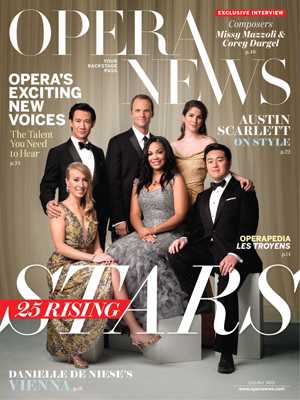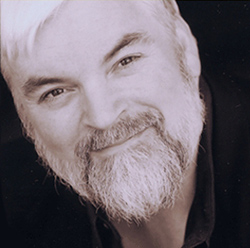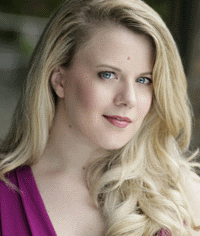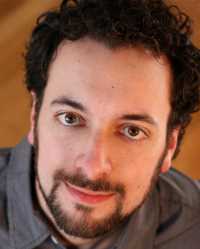Sacrifice
Saturday, March 12, 2016 • 7:30 p.m.
First Free Methodist Church (3200 3rd Ave W)
Orchestra Seattle
Seattle Chamber Singers
Clinton Smith, conductor
Andrew Stenson, Evangelist
Clayton Brainerd, Jesus
Catherine Haight, soprano
Sarah Larsen, mezzo-soprano
Jonathan Silvia, Pilate
Program
Johann Sebastian Bach (1685–1750)
St. John Passion, BWV 245

About the Concert
Composer Robert Schumann called the St. John Passion “one of the most profound and perfected works of Bach.” According to conductor and Bach scholar John Eliot Gardiner, “it packs a more powerful dramatic punch than any Passion setting before or since” and “is as bold and complex an amalgam of storytelling and meditation, religion and politics, music and theology as there has ever been.” Heading a stellar roster of vocal soloists as our Evangelist for this performance is Andrew Stenson, recently featured on the October 2015 cover of Opera News.
Behind the Music
Get the inside scoop! Hosted by OSSCS music director Clinton Smith, “Behind the Music” explores who and what inspired composers to create. Enjoy a free, fun and informative half-hour session that includes an overview of the music, historical and cultural context for the works, and highlights to listen for during the performance. Begins at 6:30 p.m. (one hour prior to the performance) at First Free Methodist Church.
About the Soloists

Tenor Andrew Stenson, the recipient of a 2011 Sara Tucker Study Grant from the Richard Tucker Foundation, is quickly building a reputation as one of the country’s most exciting young vocalists, with a brilliant tone, artistic intellect and superb portrayals of a variety of roles. During the 2014–2015 season, Mr. Stenson continued as a member of Metropolitan Opera’s Lindemann Young Artist Development Program, singing Beppe in a new production of Pagliacci, conducted by Fabio Luisi. Last summer, he returned to the Glimmerglass Festival singing the title role in Candide, directed by Francesca Zambello. This seasons he debuts with the Milwaukee Symphony in Così fan tutte, with Lyric Opera of Chicago in the world premiere of Bel Canto by Jimmy López, and with Arizona Opera in Don Giovanni. During the 2013–2014 season, Mr. Stenson performed Demetrius in The Enchanted Island at the Metropolitan Opera, returned to Seattle Opera as Tonio in La fille du régiment, and made his role debut as Belmonte in Die entführung aus dem Serail with Utah Opera. On the concert stage, he has appeared with the Seattle Symphony, Nashville Symphony and Hartford Symphony. In June 2014, he made his Washington National Opera debut as Danny Chen in Huang Ruo’s An American Soldier. Learn more: fletcherartists.com

Bass-baritone Clayton Brainerd has sung leading roles with major orchestras and opera companies around the world under the baton of Michael Tilson Thomas, Charles Dutoit, Robert Shaw, Gerard Schwarz, Jeffrey Tate, Jesús López-Cobos and Christoph von Dohnanyi. Mr. Brainerd sang in Les Troyens at Tanglewood with James Levine conducting, Oedipus Rex with the Boston Symphony, Wotan (cover) in Die Walküre on the Metropolitan Opera tour of Japan and Sachs (cover) in Die Meistersinger von Nürnberg at the MET, and also made his debut at the Paris Opéra (Bastille) in La Damnation de Faust with Seiji Ozawa on the podium. His versatility extends to many roles in the Italian and French operatic repertoire, including Mephistopheles in The Damnation of Faust, Scarpia in Tosca and Commendatore in Don Giovanni. Learn more: claytonbrainerd.com

Soprano Catherine Haight appears frequently with the region’s most prestigious musical organizations, regularly performing in Pacific Northwest Ballet’s Carmina Burana and The Nutcracker. Reviewing PNB’s world premiere of Christopher Stowell’s Zaïs, The Seattle Times called her singing “flawless.” She appears as soprano soloist on the OSSCS recording of Handel’s Messiah, the Seattle Choral Company recording of Carmina Burana, and on many movie and video game soundtracks, including Pirates of the Caribbean, Ghost Rider and World of Warcraft. Recent concert performances include Bach’s Mass in B Minor and Handel’s Israel in Egypt with OSSCS, Barber’s Knoxville: Summer of 1915 with Seattle Collaborative Orchestra and Richard Strauss’ Four Last Songs at Seattle Pacific University, where she has served on the voice faculty since 1992. Learn more: spu.edu

Mezzo-soprano Sarah Larsen, praised as “sizzling,” “riveting” and possessing a “plummy, ripe mezzo,” began her 2015–2016 season with a return to Wolf Trap Opera as Susanna in The Ghosts of Versailles and in Steven Blier’s The Rodgers Family—A Century of Musicals. She makes her house and role debut with Arizona Opera as Donna Elvira in Don Giovanni and joins the Boston Youth Symphony as Tisbe in La Cenerentola. Future engagements include Mozart’s Mass in C Minor with the Fresno Master Chorale, a debut in the inaugural season of the Berkshire Opera Festival and a return to Seattle Opera. In 2015 Ms. Larsen joined the Metropolitan Opera roster as La Muse/Nicklausse (cover) for Les contes d’Hoffmann, made her debut with the Pacific Symphony as Mercédès in Carmen, and returned to Seattle Opera as the Composer in Ariadne auf Naxos. In May 2013, she premiered a new song cycle, Farewell, Auschwitz by Jake Heggie and Gene Sheer, with Music of Remembrance, a recording of which is now available on the Naxos label. Learn more: sarahlarsenmezzo.com, @sarahlarsenmezz

Bass-baritone Jonathan Silvia has been attracting notice with his distinct timbre, secure technique, fine musicianship and incisive interpretative gifts. He has appeared at Des Moines Metro Opera, singing the title role of Carlisle Floyd’s Markheim, and at Opera Tampa as Colline (La Bohème). For Seattle Opera, he has performed several principal roles, most recently as the High Priest of Baal (Nabucco). Appearances with other Northwest opera companies include Colline (La Bohème) and Sam (Trouble in Tahiti) with Tacoma Opera, Figaro (Le Nozze di Figaro) with Kitsap Opera, Ramfis (Aïda), Sarastro/Sprecher (The Magic Flute) and Alidoro (La Cenerentola) with Skagit Opera, and Leporello (Don Giovanni), Zuniga (Carmen) and Basilio (Barber of Seville) with Vashon Opera. With Music of Remembrance, he portrayed Death in Ullmann’s Emperor of Atlantis to critical acclaim. In 2014, Mr. Silvia premiered The Lost Voice, a one-act children’s opera by Aaron Grad. A frequent concert artist, he performs and records regularly with the Byrd Ensemble. Learn more: silviasound.com
Program Notes
Johann Sebastian Bach
St. John Passion, BWV 245
Bach was born in Eisenach, Germany, on March 21, 1685, and died in Leipzig on July 28, 1750. He composed this work around 1723 and presented the first performance in Leipizg on April 7, 1724, later revising it repeatedly. In addition to vocal soloists and chorus, it calls for 2 flutes, 2 oboes, oboe d’amore, 2 English horns, strings and continuo.
In his intense and highly “personal” setting of the story of the Passion (suffering) of Christ as it appears in the Gospel of John, Bach describes musically the events leading to the triumph of Christ, the “victorious victim,” over death, the most ferocious and most fearsome enemy. According to accounts of the music Bach left at his death, he composed five settings of the Passion story, but only two survive intact: the St. John Passion from around 1723 and the St. Matthew Passion (approximately 1729). Bach’s St. John Passion is one of the most stunningly powerful of all the musical settings of the Passion, following in its choruses and solos the biblical text (in Martin Luther’s German translation) that describes what transpired during the final days of Jesus’ life. The narrative is interspersed with contemplative reflections in freely composed verse and highly expressive chorales (hymns) that comment penetratingly on events as they unfold.
J.S. Bach was born into a family that produced at least 53 prominent church and town-band musicians over seven generations. Young Sebastian began his professional career at 18, when he was appointed organist at a church in Arnstadt. At age 23 he became court organist and chamber musician to the Duke of Weimar, and during his nine years in this post (1708–1717) he gained fame as an organ virtuoso and composer. From 1717 to 1723, he served the Prince of Anhalt-Cöthen, producing suites, concertos, sonatas for various instruments and a large quantity of keyboard music.
When he was 38, Bach secured one of the most important musical posts in Germany: the position of Cantor (music director, composer, choirmaster and organist) of St. Thomas’ Church in Leipzig, a job that also involved teaching at St. Thomas’ choir school and directing the music at the city’s four main Lutheran churches (including St. Thomas and St. Nicholas). In this post, which made him, for all practical purposes, the “music director of the city of Leipzig,” the seemingly indefatigable composer produced monumental musical masterworks despite being occupied by the cares of his large family and circle of friends, and the tasks of his very busy professional life. He also suffered ongoing struggles with the officials of town, school and church, who never recognized that they were dealing with perhaps the greatest musical genius ever born. The composer described himself as living “amidst continual vexation, envy, and persecution,” but he remained at his post in Leipzig for 27 years. At last, Bach went blind and suffered a stroke, followed by a raging fever. On July 28, 1750, he died, leaving a meager worldly estate, but bequeathing an incalculable wealth of musical treasures to succeeding generations.
The tradition of reading on Good Friday one of the four Gospel narratives that describe Jesus’ suffering and death dates back some two millennia, and continues today in most liturgical churches. From Medieval times, these texts were chanted by multiple readers, a medium voice singing the words of the narrator (“Evangelist”), a lower voice singing those of Jesus, and higher voices singing the words of the Jews and of various individual characters in the “drama” (Peter, Judas, Pontius Pilate, etc.). By the late 1400s, Passion settings appeared in which the simple plainchants began to be embellished by the addition of more vocal lines to create harmonies. In the 17th century, Passions started to receive more elaborate operatic treatments: orchestral accompaniments were included, and the Passion texts from the Gospels began to be paraphrased and poeticized, or expanded by insertions of other biblical passages, freely written poetic meditations and verses from familiar hymns. The Good Friday Passion presentation was meant not only to tell a well-known story as dramatically and memorably as possible, but to convey the story’s deeper meanings to the assembled worshippers—therefore composers of Passion settings were expected to be “musical theologians” as well. Bach, sometimes called the “fifth evangelist” (the other four being the authors of the Gospels of Matthew, Mark, Luke and John) because of his unparalleled evocations of the suffering and death of Jesus, was better able than any other composer to explore both the Gospel texts (usually set as dramatic musical recitations by a soloist or as shorter choral declamations) and their significance to himself and his hearers (through the arias, hymn texts and extended choruses).
Bach’s setting of St. John’s Passion narrative was probably composed either early in 1723 or during early 1724. Bach had applied for the post of Cantor of St. Thomas’ at the end of 1722, expected to receive the appointment, and thus needed to be prepared to perform a dramatic Passion setting at St. Thomas’ Church during Good Friday Vespers in 1723. Since, however, Bach was not appointed Cantor until May, he was not able to present a Good Friday Passion until the next year. The St. John Passion was performed for the first time, therefore, on Good Friday of 1724, at St. Nicholas’ Church. Bach altered the work in various ways over the course of 25 years and through several more presentations under his direction, but in the years before his death he revoked most of his structural changes and increased the orchestral forces required for the work’s performance.
Passion music was still a central part of the evening worship that took place on Good Friday in the Lutheran churches of Bach’s Leipzig, and Passion settings were required to contain the complete and unchanged text of the Gospel (John 18–19). Devotional poems and chorale verses could be added to the biblical text, however, to enhance its meaning. The St. John Passion’s librettist remains unknown, but if Bach himself chose its texts (as is likely), he added two excerpts from St. Matthew’s Passion account to St. John’s: the weeping of Peter following the cock’s crowing, and the descriptions of the rending of the Temple’s curtain and of the earthquake that occurred after Jesus’ death. He also based some arias and ariosos and the last great chorus upon portions of the famous poetic paraphrase of the Passion story published in 1712 by Barthold Heinrich Brockes (a multi-talented Hamburg town councilor) called Jesus Martyred and Dying for the Sins of the World, which was set to music by numerous musical luminaries of the day, including Handel. Bach also included some texts from librettist and lawyer Christian Heinrich Postel’s St. John Passion of about 1700 (for which Handel had composed music at the age of 19) and from the 1675 Thoughts Necessary to Growing Youth by the poet and dramatist Christian Weise, in addition to choosing appropriate chorale texts.
The St. John Passion consists of 68 sections or movements of varying textures and lengths grouped into two parts, both of which conclude with straightforward four-part chorale harmonizations, the first part to be presented before the sermon, and the second and much longer part after it. A tenor (the Evangelist, the “voice” of the author of the Gospel of John himself) narrates the story of Jesus’ suffering, death and burial through recitatives accompanied by organ and bass instruments only. The parts of individual characters, including Jesus, are taken by soloists, while the speeches of several persons and of the crowds are sung by the chorus. Solo arias and ariosos (a “lighter” form of aria that lacks repeated sections) inserted here and there express the reactions of individuals to the events of the story, and chorale verses give voice to the responses of the entire Christian congregation. These chorales, generally set quite simply in four parts, play a very significant role in the work and provide rare touches of tenderness. Two mighty choruses frame the entire composition and express the main idea of the Passion: Christ’s divine power and love triumph over evil and death through his willing submission to suffering, and he thereby frees us as well from death’s power so that we can become his disciples and share his life. But the history-changing and heart-shattering events of the Passion are so powerful that they spill out of this framework; hence Bach concludes the work with a wondrous chorale expressing the longing of the worshiper to experience, after death, the Easter joy of seeing and eternally praising Jesus who is both Savior and throne of mercy.
The first portion of Part One of the St. John Passion deals with the betrayal and capture of Jesus. Following a roiling, anguished orchestral introduction, the chorus begins its statement of the work’s main concept (Christ the Lord as victorious victim), asking to be shown how the Lord’s glorification—despite the greatest abasement—was accomplished through suffering. The music, both an anthem of praise and a lament, features the bitter, dissonant sighing of the oboes, circling and sorrowing (but somehow regal) repeated sixteenth-note patterns in the strings, and a throbbing eighth-note heartbeat in the bass. The voices of the chorus descend at the words “even in deepest humiliation” and strive to rise again at “are glorified.” The Evangelist begins the story with Jesus’ betrayal by Judas, with the chorus taking the part of the crowd, then reflecting on the events through the texts of the chorale verses. As Jesus is bound and led away, an alto aria contrasts the bondage of the Savior with the freedom from sin that his bondage wins for the believer as imitatively interlacing oboes bring to mind the cords that secure Jesus’ hands.
The second portion of Part One describes Peter’s denial that he has ever known or been associated with Jesus. Initially, Peter follows his captured master and the soprano soloist affirms the believer’s commitment to follow him as well in an aria in a joyful, dance-like triple meter with flute accompaniment. The musical lines imitate one another as the disciple should imitate Christ. As the questioning of Jesus begins and he is struck on the face, a chorale verse observes that it is our sins that caused his beating. When Peter has denied his knowledge of Jesus three times, the text of Matthew 26:75 describing Peter’s bitter tears of remorse is inserted into St. John’s narrative: the long, jagged, highly chromatic vocal line at the words “wept bitterly” brings to the listeners’ ears Peter’s agonized wail of sorrow. As the first part of the Passion ends, the tenor soloist—his lines filled with dramatic leaps, stabbing rhythms and deep signs—laments the fact that the soul can find no refuge (now that the servant has denied his Lord) and the chorus asks that the worshipers’ consciences be kept from slumbering as Peter’s slept.
Part Two of the Passion, which deals with the interrogation and flogging of Jesus and with his death and burial, opens with a chorale wondering at the fact that the innocent Savior is taken like a thief and forsaken by his friends. When Pontius Pilate begins to question the hostile crowd, the increasingly agitated music given to the chorus features a rising chromatic “stalking” figure and the three-note (long–short–short) motive reminiscent of flogging that later becomes the crowd’s cry, “Crucify!” This part of the work features “chiastic” structures, musical architectures named after the Greek letter χ (chi, which is not only cross-shaped but also the first letter of the name of Christ) and built symmetrically around central axes: ABCBA. To construct them, Bach uses the same music for different short texts spoken during the Passion narrative by the “crowds” and sung by the chorus. In order to arrange his musical numbers symmetrically around a “center” of particular theological importance, he distributes related choruses in sometimes widely separated portions of his score. The “centerpiece” (literally the “crux”) of this portion of the Passion—its core, focus and “fulcrum”—is the chorale “Through your imprisonment, Son of God, must come our freedom” (40), which expresses for Bach the essential meaning of Christ’s Passion. In this scene in the Judgment Hall before Pilate, two choruses (29, 34) separated by solos (31, 32) form a unit that reappears with similar music in later choruses (46, 50) separated by another solo (48). Two more chorales (27, 52) frame the section as a whole. Bach thus builds the following musical structure (omitted numbers correspond to settings of the biblical texts as recitatives):
| A | B | C | D | E | D | C | B | A |
| 27 | 29,31,32,34 | 36 | 38 | 40 | 42 | 44 | 46,48,50 | 52 |
One of the work’s most beautiful and distinctive portions is the bass arioso (31) with its following tenor aria (one of the most technically demanding solos Bach ever wrote), in which Bach employs the text’s reference to a rainbow (the arch of bloody welts left by the whip on Jesus’ back) to illustrate musically the concept of endless mercy. Here Bach contrasts the wrenching picture of the pain-wracked, nearly fatally scourged Jesus with the ineffable joy arising from his self-sacrifice. These two pieces depict with heart-piercing power Bach’s deepest faith. The choruses of the Jews (whom the author of the Gospel of John sees as the “nationalists” or “patriots” who could not see God enfleshed in the person of Jesus) in this part of the work are wild, chaotic and frenzied: Bach paints a frighteningly realistic portrait of a crowd degenerating into an uncontrolled mob through the use of angry dissonances, the “crucify” motive and clashing parallel musical lines. The somewhat pompous populace (38), supposedly concerned with following the Jewish law (the music, ironically, takes the form of a fugue, in which the voice lines follow the strict “laws” of imitative counterpoint), becomes increasingly lawless in its insistence that Jesus’ “making himself the son of God” must be punished by death. These scenes fit well with the highly forceful, nearly violent recitatives. The “hurrying” bass aria (48), in which agitated exclamations of the chorus (“Where to?”) continually disrupt the music of the soloist as he urges the listeners to hasten to Golgotha (the place of crucifixion where salvation blossoms) is especially dramatic.
The rattling and rolling of dice by the soldiers who are gambling at the foot of Jesus’ cross can be heard (54) in instruments and voices—Jesus’ garment is finally won by the sopranos on a high A! Soon after another chorale (sung to the same music that ended Part One as Bach contrasts Jesus’ concern for his mother as he dies with Peter’s thoughtlessness) comes one of Bach’s most formally unconventional arias (58), “It is completed.” This alto aria’s initial section is developed from the descending melodic line in which Jesus, his head drooping in death, gasps out his last words, but the contrasting triumphal section reminds us that Jesus’ death is not a defeat, but a victory: his great struggle with death “is finished,” salvation “is accomplished,” Jesus is the conqueror, and all creation can dance for joy (as the music of the ensuing bass aria [60], upon which is superimposed the chorale music, softly sung, that ended Part One, and which is the counterpart to the previous bass aria [48], reminds the listener). This victory, however, celebrated with lilting dance and gentle hymn combined (60), will not be clear until Easter Day! Bach emphasizes the significance of this aria to the Passion’s theme of “Christ as victor” by giving the alto aria (58) the central place in three different chiastic structures in Part Two of the Passion.
The Evangelist next describes (61) the frightening events that accompany Jesus’ death as related in Matthew 27:51–52. The veil of the Temple is ripped apart through two octaves of rapidly descending notes in the accompaniment, while the low instruments shake and the Earth quakes; the Evangelist’s line rises as dead bodies emerge from their graves. Solo tenor and then solo soprano observe that the whole world is plunged into grief and woe as Jesus dies; in the soprano lament (63), the deepest grief is expressed through recurring bursts of short notes, sobbing off-the-beat repeated-note figures in the bass, and sighing figures in voice and winds. The Evangelist then presents St. John’s description of Jesus’ removal from the cross, and a chorale (65) expresses the worshipers’ desire for the Savior’s help in vanquishing evil and giving proper thanks for Jesus’ sacrifice: Bach uses the same music that begins the second part of the Passion, bringing it full circle. After the Evangelist describes Jesus’ burial in the garden sepulcher, the chorus, in a majestic “funeral procession/lullaby,” wishes that Jesus might “rest well,” because the grave will at length release him, and he will close Hell’s gates and open Heaven for the believer. As noted above, the work concludes with one last chorale: “Ah Lord, when comes that final day, may Angels bear my soul away,” which might be interpreted as Bach’s own prayer that he be allowed to exercise such prodigious musical gifts as he displays in this masterpiece in the eternal praise of his risen Lord.
Donald Teeters, longtime music director of the Boston Cecilia, observed that, for the past 70 years, the St. John Passion and its performance have engendered controversy because of the anti-Judaism that some perceive in the work. The Gospel of John does attribute most of the responsibility for Jesus’ death to “the Jews,” understood not as all those of Jewish descent, but as those who refused to recognize Jesus as the promised Messiah and who were chiefly concerned with the maintenance of the Jewish state—the Christian Church has, to its shame, demonstrated an anti-Jewish prejudice that has been used to rationalize the persecution of Jewish people over many centuries. Bach, however, takes the Gospel text as eyewitness history and sets it powerfully as such, but through the devotional elements in his Passion setting (the arias and chorales), which comment and reflect upon the scriptural texts, he emphasizes the responsibility of everyone, including the individual Christian and the Christian community: “I, I, and my sins, that are as many as grains of sand by the sea, have provoked for you the misery that has struck you, and the host of troubles and torment” (15). Bach identifies his listeners with St. John’s “Jews,” implicating the people of Leipzig in the crucifixion of Jesus, and with them all who seek personal power and comfort rather than justice, mercy and the good of others. As a “musical theologian,” Bach calls everyone to turn to the one whose victory is achieved through the willing sacrifice of himself for the life of the cosmos. The meaning of Bach’s composition is therefore rendered personal and contemporary (for Bach’s listeners as well as for ourselves), and Bach does not lay the blame for Christ’s passion and death solely upon the villains of St. John’s account. Viewed thus from a post-Holocaust perspective, Bach’s great work can remain a superlative artist’s proclamation of his own faith “to the glory of God,” as well as an example of universally redemptive art.
—Lorelette Knowles
